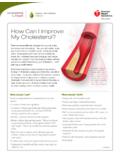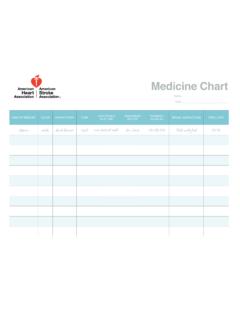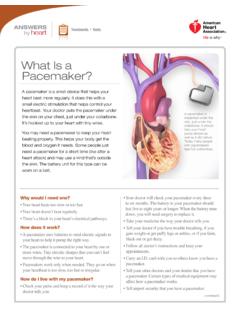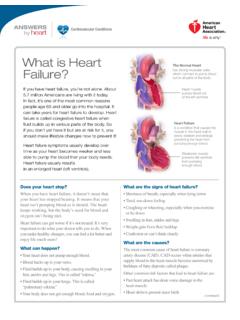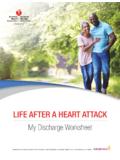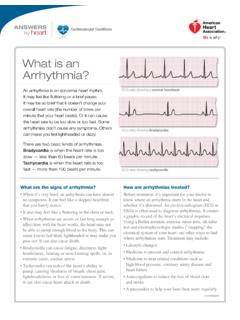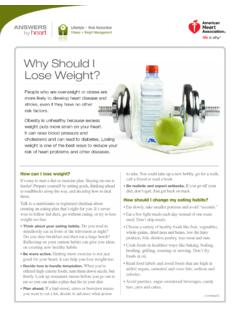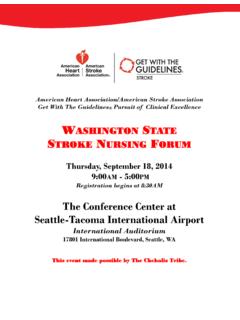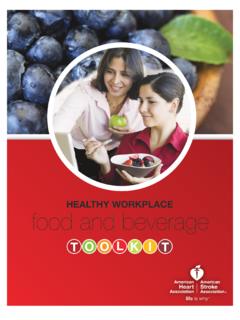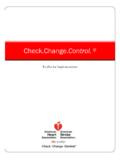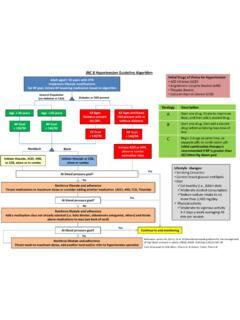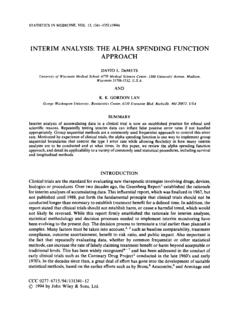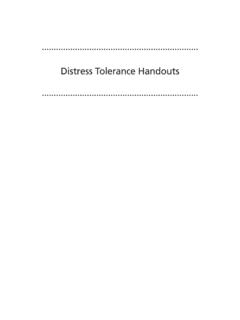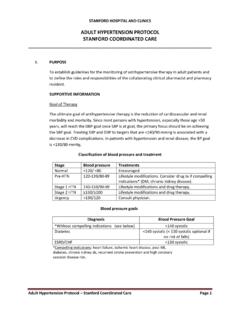Transcription of Cardiogenic Shock
1 Cardiogenic ShockMichael Liston Cardiogenic Shock (CS) is a clinical condition of inadequate tissue(end organ) perfusion due to cardiac dysfunction Hypotension (SBP < 80-90 mmHg) or MAP 30 mmHg below baseline Reduced cardiac index(< L/min per m2) < L/min per m2 with support Adequate or elevated filling pressuresDifferentiating types of Shock Etiology PCWP CO SVR SVO2 Hypovolemic v v ^ vCardiogenic ^ v ^ vSeptic v or = ^ v ^Prevalence Occurs in 5-8% of STEMI and of NonSTEMI 40,000-50,000 cases annually in the USMortality Current registries suggest a mortality rate of about 50% Historically rates quoted as high as 80-90% With early revascularization.
2 Newer modalities and aggressive treatment rates improvingMortality Risks Older age Female sex Anterior wall STEMI Hypertension Type II Diabetes MultivesselCoronary Artery Disease Prior STEMI or Angina STEMI with new LBBB History of Heart FailureEtiology Acute myocardial infarction with left ventricular failure (or rv failure) Acute mitral regurgitation Ventricular septal or free wall rupture Any other cause of acute right or left ventricular dysfunctionother etiologies Severe valvular heart disease (AS, AI, MS or MR) Post cardiotomy Acute fulminant myocarditis End stage cardiomyopathy Hypertrophic cardiomyopathy with severe LVOT obstruction Aortic dissection with acute severe AI or Tamponade Pulmonary Embolus Incessant refractory or prolonged tachyarrhythmias post cardiac arrestCardiogenic ShockWho is at risk?
3 Older age Female sex Anterior wall STEMI Hypertension Type II Diabetes Multivessel Coronary Artery Disease Prior STEMI or Angina STEMI with new LBBB History of Heart FailureSigns and Symptoms Hypotension Absence of hypovolemia Tachycardia Clinical signs of poor perfusion (ie oliguria, cyanosis, cool extremities, altered mentation)Physical Exam Skin-Ashen or cyanotic and cool, mottled Peripheral pulses rapid and faint, irregular JVD, Rales, Edema may be present Heart sounds distant, S3 or S4 Pulse pressure low Decrease CO, Increased SVR, Decreased SvO2 Figure 1. Current concept of CS pathophysiology. Reynolds H R , and Hochman J S Circulation. 2008;117:686-697 Copyright American Heart Association, Inc.
4 All rights Increased catecholamine-peripheral arterial constriction -maintain perfusion to vital organs Vasopressin and Angiotensin II levels increase -increases coronary and peripheral perfusion -cost of increased LV afterload leading to further LV impairment Activation of neurohormonalcascade -promotes salt and water retention -improving perfusion at the cost of worsening pulmonary edema Reflex mechanisms to increase SVR not fully effectiveWhat about RV dysfunction? 5% of CS cases from MI Typically pts have High RVEDP > 20mmHg Limited LV fillingdecreased cardiac output (preload)ventricular interdependancethink pericardium and intraventricularseptum Treatment is to assure adequate right sided filling pressure and adequate LV preloadMore on CS due to RV Increases in RVEDP lead to RV dilation, septum bulging into LV, increases LA pressure and impaired LV systolic function Low RVEDP will affect LV preload and CO Optimal RVEDP range 10-15 mmHg Hemodynamic monitoring likely to be beneficial Mortality risk for CS due to primary RV dysfunction nearly as high as LV dysfunction Early Revascularization carries same survival benefitsIatrogenicAre we contributing?
5 Beta blockers , Ace Inhibitors, MSo4decrease bp, slow heart rate and decrease in cardiac contractility may cause CS in certain High Risk patients Diuretics-in some patients pulmonary edema due to decreased LV compliance and net redistribution of intravascular volume to the lungs-further decline in circulating intravascular volume with diuretic use could lead to hypotension and Shock -(lv compliance first to go in MI)-Treat with low dose diuretics, nitrates, seated position to reduce preload Excess volume loading in RV infarct (Swan-Ganz ?)Figure 3. Iatrogenic Shock . Reynolds H R , and Hochman J S Circulation.
6 2008;117:686-697 Copyright American Heart Association, Inc. All rights inflammatory response Inappropriate vasodilation impaired perfusion of GI tract Transmigration of bacteria Sepsis Risk for SIRS increases with duration of shockInitial Treatment and Evaluation EKG, ABG, Lytes, CBC, Troponin Urgent Transthoracic Echocardiogram ABC s CirculationTreat arrhythmiasArt LineUrinary CatheterCentral venous (Swan-Ganz) catheterTreatment cont. Aspirin and Heparin Dual antiplatelet therapy for PCI(not before) Maintain SaO2 and pH Aggressive insulin tx forhyperglycemia Low threshold for mech ventilation(PEEP reduces preload and afterload) & (reduces work of breathing) REVASCULARIZE!
7 Hemodynamic Monitoring Swan-Ganz (PA catheter)-monitor cardiac output-monitor filling pressures (pap, pcw, rvedp)-continuous- ECHO Assessment-Estimated peak pap-Estimate pcw (MV early diastolic deceleraton time)(<140 msec = pcwp > 20 mmHg)-onetime or intermittent-Pharmacologic Support Norepinephrine (Levophed) Dopamine Dobutamine (Dobutrex) Phenylephrine Isoproterenol (Isuprel) IV Fluids Avoid negative inotropes and vasodilators(use lowest doses possible)Receptor Activity Alpha-1 receptorsmooth muscle contractionvasoconstrictionincreased SVR Beta-1 Increased heart rateincreased myocardial contractility Beta-2 Smooth muscle relaxationDecreased SVR DopamineVasodilation (low dose)Increased cardiac outputVasoconstriction (high dose)
8 Vasoactive medication Vasopressors always required-use lowest doses possible-higher doses associated with poorer survival Inotropes treat for contractile failure-increases myocardial atpues-increases myocardial oxygen demand-Dobutaminemay be useful if bpadequate AHA recommends norepinephrine first-8-12 mcg/min and titrate Dopamine has inotropic properties Isoproterenol to treat Shock due to bradycardia Phenylephrine to increase afterload in hocmor certain cases of Tako-Tsubo IABP-improve coronary and peripheral perfusion-initiate as quickly as possible-higher rates of survival in high use centers Newer devices-LV, RV or BiVassist devices-impella, tandem heart, extracorporeal life support (ecls)-Trials have shown hemodynamic improvement but no survival benefit thus farMechanical SupportIABP Shock II Trial 600 patients all treated with ERV and optimal medical therapy then randomized to IABP(300) or no IABP(298).
9 Morality rate at 30 IABP and no IABP (p= ) placed after PCI 10% of no IABP group crossed over(AHA Class IIarecommendation) Danish Cardiogenic Shock Trial (DanShock) Conventional therapy vs Impella LVAD began enrollment in 2012 Reperfusion Percutaneous coronary intervention (PCI) Coronary Artery Bypass Grafting (CABG) Thrombolysis for patients not receiving pci or cabgShock Trial(Should we emergently revascularizeOccluded Coronary arteries for Shock ) 302 patients randomized to either emergency revascularization (erv) or initial medical stabilization (ims) ERV-revascularization (PCI or CABG) within 6 hours of randomization IMS-could undergo delayed revascularization a minimum of 54 hours post randomization Shock Trail Primary cause of Cardiogenic left ventricular severe mitral ventricular septal isolated right ventricular tamponade or cardiac rupture8% other causesFigure 5.
10 Long-term follow-up of the Shock trial Early revascularization (ERV) is associated with sustained benefit. Reynolds H R , and Hochman J S Circulation. 2008;117:686-697 Copyright American Heart Association, Inc. All rights Trial 13% increased 1 year survival with early revascularization (nnt = 8) 37% of early revascularizaton pts had CABG Rate of CABG in community < 10% 87% of pts in Shock Trial had multivessel diseaseQuality of Lifeas assesedby NYHA functional class Revascularized NYHA class 1-11 2 weeks post DC Control group NYHA class 1-11 2 weeks post DC 55% of those class 111-1V pts at 2 weeks that survived to 1 year improved to NYHA class 1-11 Figure 6.
